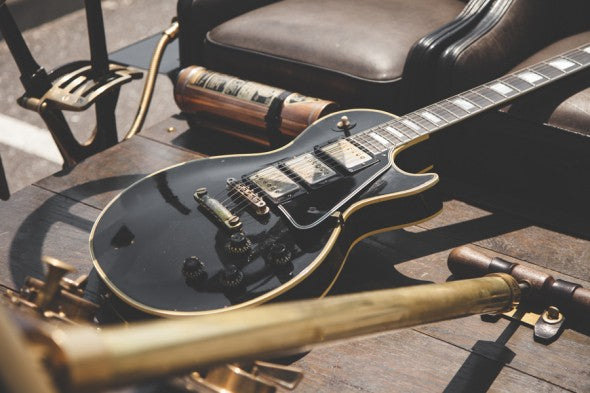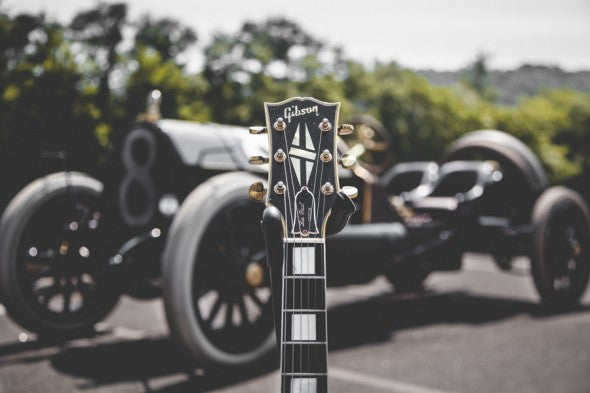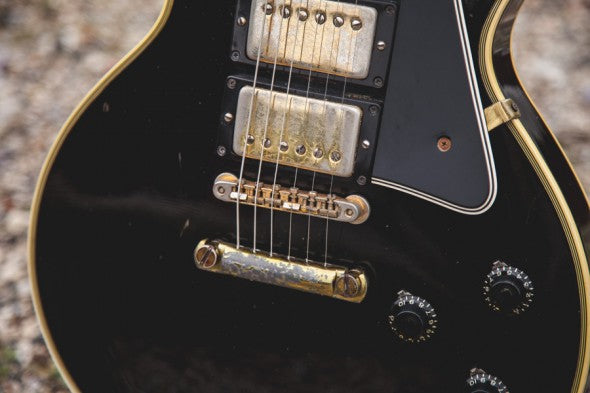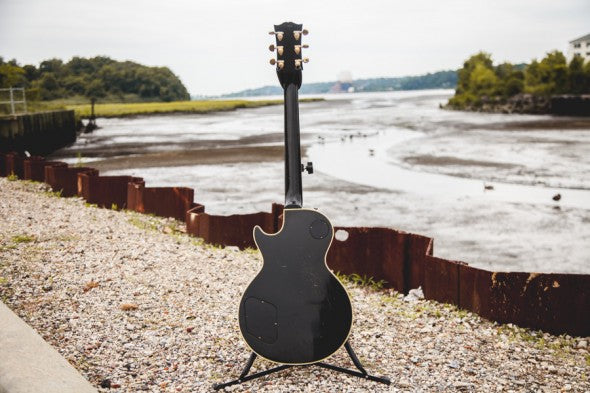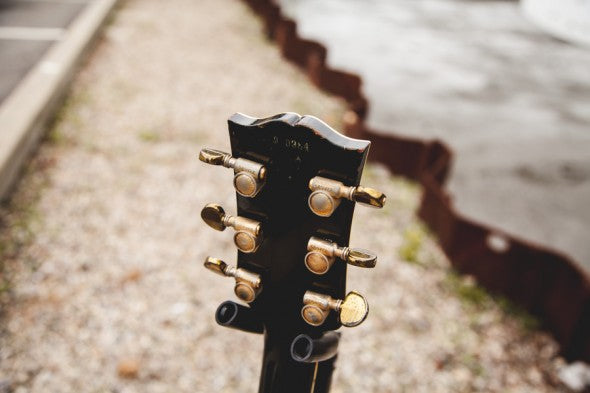Cars & Guitars: Beauty And The Beast
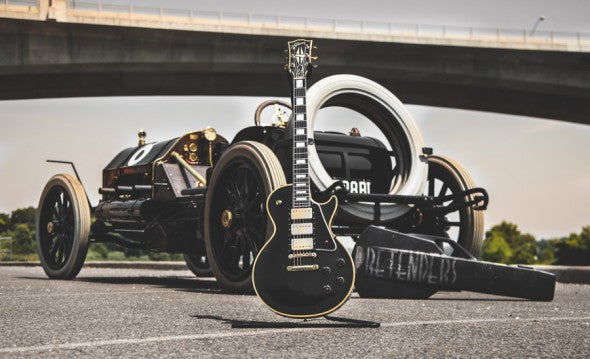
Every so often in Roslyn, New York, a quaint suburb of New York City located on the north shore of Long Island, the relative quietude of a town that takes its colonial-era history all too seriously gets shattered by a car dubbed The Bete Noire, or The Black Beast. It’s loud. It backfires. It snorts and chortles, and it sounds more like a rip-roaring locomotive than an automobile. It turns out that The Black Beast was built in 1909 by the American Locomotive Company, which manufactured cars for a brief spell in the early 20th century. They were loud cars, built for an upscale market and priced from $5,000 to $7,500.
 More than 100 years since its roll-out, the Black Beast, a 1909 Alco six-cylinder racer, resides at 55 Lumber Road in Roslyn, in the very same building that’s home to The Music Zoo. If you want to talk about loud, this is where loudness and darkness reign supreme; loud cars, loud guitars, Marshall amps, spark plugs, an old Shelby Mustang, Charvel guitars and shred-friendly Jacksons, gorgeous Fender and Gibson Custom Shop instruments…all under the same roof. In fact, The Music Zoo has its own kind of Bete Noire, actually a Beaute Noire in the form of a 1959 Gibson Les Paul Custom that was owned by late Pretender’s guitarist James Honeyman-Scott. Hence, we’ve got a Beauty and the Beast right under one roof…pretty radical for a village where old schoolteachers walk around dressed like it’s 1776 for thrills, and where George Washington once rented a room before leading the troops into the Battle of Brooklyn.
More than 100 years since its roll-out, the Black Beast, a 1909 Alco six-cylinder racer, resides at 55 Lumber Road in Roslyn, in the very same building that’s home to The Music Zoo. If you want to talk about loud, this is where loudness and darkness reign supreme; loud cars, loud guitars, Marshall amps, spark plugs, an old Shelby Mustang, Charvel guitars and shred-friendly Jacksons, gorgeous Fender and Gibson Custom Shop instruments…all under the same roof. In fact, The Music Zoo has its own kind of Bete Noire, actually a Beaute Noire in the form of a 1959 Gibson Les Paul Custom that was owned by late Pretender’s guitarist James Honeyman-Scott. Hence, we’ve got a Beauty and the Beast right under one roof…pretty radical for a village where old schoolteachers walk around dressed like it’s 1776 for thrills, and where George Washington once rented a room before leading the troops into the Battle of Brooklyn.
Speaking of thrills, The Music Zoo recently talked our landlord and Black Beast owner, Howard Kroplick, into allowing us to pose our Beauty with his Beast amidst Roslyn’s lovely harbor surroundings. For this wild and crazy stunt, Walter Bryant, the Zoo’s staff photographer, and Kroplick took the Black Beast for a little spin where it made some noise and turned some heads. It was truly a Beauty and the Beast mash-up.
The Black Beast is considered one of the very first combustion engine racing cars, built and designed when the “horseless carriage” concept was just getting its wheels, so to speak, and when car sales were influenced by how the machines performed on the racetrack (Henry Ford supposedly remarked that “Victory on Sunday means sales on Monday”). With its  six-cylinder, 100-horsepower engine, Alco sponsored the car in numerous races with its test driver, Harry Grant, leading the Black Best to victory in almost all of them. One noteworthy win was the 1909 and 1910 Vanderbilt Cup races, which took place on Long Island and was organized by William K. Vanderbilt (heir to the railroad tycoon). Indeed, the Black Beast was fast—keeping pace at roughly 62 miles per hour, but also victorious as a result of simply being an excellently built automobile that rarely broke down. Actually, one of the few instances of breakdown occurred during the very first Indy 500, when a bearing failed on the 52nd lap.
six-cylinder, 100-horsepower engine, Alco sponsored the car in numerous races with its test driver, Harry Grant, leading the Black Best to victory in almost all of them. One noteworthy win was the 1909 and 1910 Vanderbilt Cup races, which took place on Long Island and was organized by William K. Vanderbilt (heir to the railroad tycoon). Indeed, the Black Beast was fast—keeping pace at roughly 62 miles per hour, but also victorious as a result of simply being an excellently built automobile that rarely broke down. Actually, one of the few instances of breakdown occurred during the very first Indy 500, when a bearing failed on the 52nd lap.
Sometimes good things must come to their ends, and the Black Beast was retired in the years preceding World War I, seldom seen or heard from until being sold to a collector in the 1930s where it lived in a barn. That collector sold the Black Beast to vintage car historian Joel Finn in 1968, who put some massive restoration work into it before selling the car in 1975 to casino tycoon Bill Harrah. Harrah had a collection of more than 1,500 cars, among which the Black Beast was probably feeling like a mere number…if it was capable of feeling. When Harrah sold the car in 1988, it bounced around Europe like some washed up movie star waiting for rediscovery, eventually winding up in France where, in 2008 it became available for sale and Kroplick was right there with a check. “I’ve followed that car for years,” he recalls. “When it was offered on the internet I jumped on it. A Belgian dealer was selling the car and I flew to Brussels to inspect the car before finalizing the deal.” It’s now parked at 55 Lumber Road in Roslyn, amidst the throbbing pulse of a neighboring dance studio and the brown sound tones of Friedman amps and a good Charvel.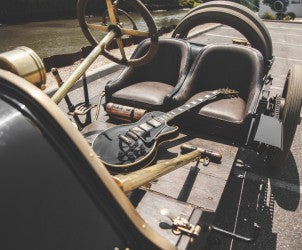
Or, a Friedman matched with a great, vintage Black Beauty Les Paul, like our James Honeyman-Scott guitar. It’s from 1959 and with all the tell-tale features from that year, such as three PAF humbuckers, gold hardware, block-inlaid ebony fretboard, the split diamond headstock inlay, and that lustrous black finish. It all coalesced into the Fleetwood Brougham of electric guitars—a class act all the way. Jimmy’s guitar came to us in an ugly but somehow cool Norlin-era Gibson “Protector” (sometimes referred to as the “Chainsaw”) from the late ‘70s with the Pretender’s logo stenciled on, but that hardly discounts from this guitar being a primo example of the 1959 Les Paul Custom. Along with the features previously mentioned, it has the period-correct low and thin fretwire (which led to the guitar earning the alternate nickname, “Fretless Wonder”), multi-ply binding, fancier gold-plated tuners, and a one-piece mahogany body that was carved on the top. The instrument’s body used an upscale multi-ply binding that added to the aesthetic (the ebony fretboard had a single-ply binding), and a total of 246 Les Paul Customs left Gibson’s Kalamazoo, Michigan factory in 1959.
Throughout his all-too-brief career, Honeyman-Scott played many different guitars as if he needed to experience the inherent greatness in all of them. He endorsed Hamer, loved his ES-335s and Firebirds, recognized the tonal possibilities of Strats and Teles, and remained partial to his Zemaitises. His Black Beauty also appeared on stage and on record and, ultimately, Jimmy used guitars like a painter or sculptor would use their tools. He was a truly dedicated musician, absorbing everything he could and taking his guitar cues from British pub rockers like Chris Spedding, Dave Edmunds, and Billy Bremner, not to mention the country influences and string tugging of Albert Lee. Yeah, this was a music fanatic, and stories persist of James Honeyman-Scott showing up at parties and plowing through the host’s record collection until he found some Beach Boys records, whereupon he’d hang out by the stereo and ignore the surrounding debauchery.
As a guitarist, Jimmy preferred subtlety instead of an overt display of chops. A perfect example is the eight-bar solo for “Kid,” where taste and melodicism make for an unforgettably concise and musical guitar statement that combines some country twang with gorgeous arpeggios using fretted and open strings. Elsewhere in the band’s repertoire, he channels some serious rockabilly and Eddie Cochran riffs to match the Pretender’s post-punk rock-meets-Kinks mashup. 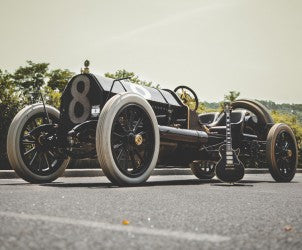 Actually, Chrissie Hynde credited Honeyman-Scott with bringing melodicism to what was originally nihilism-fueled punk.
Actually, Chrissie Hynde credited Honeyman-Scott with bringing melodicism to what was originally nihilism-fueled punk.
Time machine ahead a few decades and across continents to…Roslyn, where Black Beast and Black Beauty live together in the land of loudness and Blackness. “Kid” is playing on the radio, the Black Beast is getting readied for the next big car show, and the Black Beauty is sitting pretty in its Protector case while the Music Zoo’s staff begs owner Tommy Colletti for a turn playing it. We don’t know if Honeyman-Scott and Harry Grant are looking down in curiosity or splendor, yet we’re certain that black is the new black…not orange.
Written By Mike Bieber
Photographs By Walter Bryant




